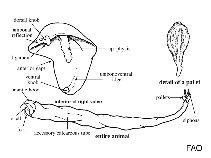Teredo navalis Linnaeus, 1758
Naval shipworm| Native range | All suitable habitat | Point map | Year 2050 |

|
| This map was computer-generated and has not yet been reviewed. |
| Teredo navalis AquaMaps Data sources: GBIF OBIS |
تصوير گوگل | No image available for this species;
drawing shows typical species in Teredinidae.
رده بندی / Names اسامي عام | مترادف | CoL | ITIS | WoRMS
Bivalvia | Myida | Teredinidae
Environment: milieu / climate zone / تغييرات عمق / distribution range بوم شناسي
; لب شور; تغييرات عمق 0 - 150 m (مرجع 76971), usually 0 - 20 m (مرجع 75831). Temperate; 11°C - 25°C (مرجع 98650); 72°N - 58°N, 25°W - 31°E
Distribution كشورها | مناطق سازمان خوار و بار جهاني (FAO) | Ecosystems | ظهور | معرفي
Northeast Atlantic: Native to Iceland, Faroe and Norway. Introduced to the Baltic Sea, Mediterranean and Pacific Ocean. Temperate to tropical.
Length at first maturity / Size / Weight / سن
بلوغ: Lm ? range ? - ? cm Max length : 50.0 cm TL جنس نر / بدون خواص جنسي; (مرجع 76971)
توصيف مختصر ريخت شناسي
Life cycle and mating behavior بلوغ | تولید مثل | تخم ریزی | Eggs | Fecundity | Larvae
مآخذ اصلی
مراجع | هماهنگ كننده | همكاران
Harms, J. 1993 Check list of species (algae, invertebrates and vertebrates) found in the vicinity of the island of Helgoland (North Sea, German Bight) - a review of recent records. Helgoländer Meeresunters 47:1-34. (مرجع 2711)
وضعيت در فهرست قرمز IUCN
(مرجع 130435: Version 2025-1)
وضعيت از نظر سايتس (مرجع 108899)
CMS (مرجع 116361)
خطر برای انسان ها
استفاده انسانی
ماهي گيري – شيلات: از بی علاقه گی
| FishSource |
ابزارها
اطلاعات بيشتر
تركيب غذايي
مصرف غذايي
شکارچیان
منابع اينترنتي
BHL | BOLD Systems | CISTI | DiscoverLife | FAO(Publication : search) | Fishipedia | GenBank (ژنوم, نوکلئوتيد) | GloBI | Gomexsi | Google Books | Google Scholar | Google | PubMed | Tree of Life | Wikipedia (برو, جستجو) | Zoological Record



